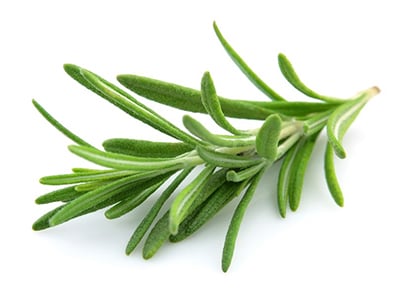 Rosemary, whose scientific name is Rosmarinus officinalis, comes from a small woody shrub. Its leaves are very narrow, resembling pine needles and have a sharp, pine-like, pungent, spicy, woody, floral flavor. It grows in the Mediterranean, among other areas, but its location there aids in explaining why it comprises a portion of the mixture known as Herbes de Provence in French cuisine (along with lavender, majoram, thyme and fennel).
Rosemary, whose scientific name is Rosmarinus officinalis, comes from a small woody shrub. Its leaves are very narrow, resembling pine needles and have a sharp, pine-like, pungent, spicy, woody, floral flavor. It grows in the Mediterranean, among other areas, but its location there aids in explaining why it comprises a portion of the mixture known as Herbes de Provence in French cuisine (along with lavender, majoram, thyme and fennel).
Harold McGee in “On Food and Cooking: The Science and Lore of the Kitchen” explains that the flavor components of rosemary are cineole, pinene, terpineol, borneol, myrcene, and camphor. Additional flavor compounds of rosemary leaves include verbenone and linalool.
Looking for rosemary products for your food formulation?
Prospector has listings for hundreds of rosemary products. View technical data, order samples and more now…
Search Rosemary Products
Rosemary oil and oleoresin are often used as a flavor for processed meats, sausages, gravies, and cheeses. Flavors such as rosemary and sage can be used to advance the flavors of sandwiches to gourmet status, or to compliment a unique sausage flavor, like lamb and mutton.
Other trendy uses for rosemary include:
- Some chefs are drying rosemary sprigs and then grinding them into a dust to use for immediate flavor impact in unique situations like on oranges or sorbet. Here is a recent example from the UK: using rosemary dust to rim the top of a unique alcoholic beverage.
- Rosemary flavored cocktails were on-trend earlier this year. Many of these are made using infused honeys, vinegars, and simple syrups.
- According to Baum+Whiteman, food and restaurant consultants, savory yogurts are on trend for snacking and in restaurants. Consider making these using rosemary as a flavor addition with an umami component, such as miso or mushroom.
- Baum+Whiteman consultants also see snacks continuing to shift from sweet to savory and spicy. Consider adding rosemary to popcorn seasonings, high protein meat and vegetarian snacks, and hummus chips.
- The addition of fresh or dried rosemary to breads and focaccias adds a unique flavor and an artisanal flair.
Recent unique offerings containing rosemary, noted in Mintel’s Global New Products Database:
- November 2015: In Greece, a Mediterranean mustard with Oregano and Rosemary was introduced. That same month saw a Greek white wine vinegar with rosemary and thyme launched in Germany.
- September 2015: A dark chocolate blended with rosemary as the flavor ingredient was launched in the UK.
- July 2015: Rosemary Truffle Kale Chips were launched in the USA, and were shown at the Summer Fancy Food Show.
- Consider the following savory jam flavors: Pear-Rosemary Jam, as well as Onion, Apple, and Rosemary Preserves.
In addition to the unique flavor it imparts to foods, its extracts and oleoresins are used in a wide variety of foods as an antioxidant or antimicrobial, including meats, oils, baked goods, and snacks and fried foods. These effects of rosemary will be covered in another article.
The views, opinions and technical analyses presented here are those of the author or advertiser, and are not necessarily those of ULProspector.com or UL Solutions. The appearance of this content in the UL Prospector Knowledge Center does not constitute an endorsement by UL Solutions or its affiliates.
All content is subject to copyright and may not be reproduced without prior authorization from UL Solutions or the content author.
The content has been made available for informational and educational purposes only. While the editors of this site may verify the accuracy of its content from time to time, we assume no responsibility for errors made by the author, editorial staff or any other contributor.
UL Solutions does not make any representations or warranties with respect to the accuracy, applicability, fitness or completeness of the content. UL Solutions does not warrant the performance, effectiveness or applicability of sites listed or linked to in any content.


